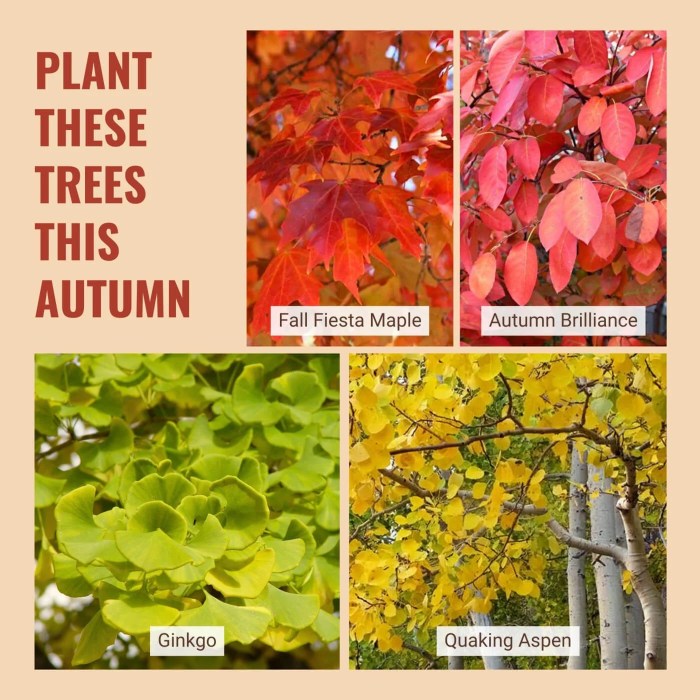Preparing the Planting Site: What Trees To Plant In Fall

What trees to plant in fall – Planting trees in the fall offers a unique advantage: the cooler temperatures and increased soil moisture provide ideal conditions for root establishment before the spring growth spurt. However, maximizing these benefits requires meticulous site preparation. Neglecting this crucial step can significantly impact your tree’s long-term health and survival. Proper soil preparation and hole digging are paramount for ensuring your newly planted trees thrive.
Preparing the soil for fall planting is more than just digging a hole; it’s about creating an environment that fosters robust root growth. This involves assessing your existing soil conditions, amending as needed, and ensuring the planting hole is appropriately sized and prepared to welcome your new tree.
Soil Amendment for Optimal Tree Growth
Soil composition dramatically influences a tree’s ability to access essential nutrients and water. Clay soils, for instance, can become compacted, restricting root penetration and oxygen flow. Sandy soils, conversely, drain too quickly, leading to dehydration. Amending the soil addresses these deficiencies, creating a balanced environment conducive to thriving trees. For clay soils, incorporating organic matter like compost or well-rotted manure improves drainage and aeration.
This organic matter enhances the soil structure, creating larger pore spaces that allow for better water infiltration and root penetration. For sandy soils, adding organic matter improves water retention, providing a more consistent moisture supply for the tree’s roots. A soil test can provide precise insights into your soil’s pH and nutrient levels, guiding you towards the most effective amendments.
For example, a soil test might reveal a need for additional phosphorus or nitrogen, which can be added in the form of slow-release fertilizers.
Step-by-Step Guide to Digging the Planting Hole
The dimensions of the planting hole directly impact a tree’s initial growth and long-term health. A hole that’s too small restricts root expansion, while one that’s too large can lead to the tree settling unevenly. The depth and width should be roughly 1.5 to 2 times the diameter of the root ball. For smaller trees, this might mean a hole only a few feet across, while larger trees could require a significantly wider and deeper hole.
Following these steps ensures a properly prepared planting hole:
- Assess the root ball: Carefully examine the root ball of your tree. Note its diameter and depth to determine the appropriate hole size.
- Dig the hole: Dig a hole that’s 1.5 to 2 times wider and as deep as the root ball. Avoid digging a hole that’s too deep, as this can bury the root flare and impede growth. The sides of the hole should be relatively straight, not sloped.
- Loosen the soil: Once the hole is dug, loosen the surrounding soil to a depth of at least 12 inches. This helps to improve root penetration and water infiltration.
- Prepare the backfill: Mix the excavated soil with compost or other organic amendments, if needed. This improves the soil’s structure and nutrient content, providing a rich environment for root development.
- Avoid placing amended soil at the bottom of the hole: This is a common mistake. Instead, mix the amended soil with the surrounding soil. This helps create a gradual transition from the amended soil to the surrounding native soil.
Planting Techniques for Fall Success

Fall planting offers a unique advantage: cooler temperatures and increased soil moisture, creating ideal conditions for successful tree establishment. However, proper planting techniques are crucial to maximize these benefits and ensure your trees thrive. Choosing the right method, watering diligently, and applying mulch correctly are key components of a successful fall planting strategy. These steps will dramatically improve your chances of a healthy, vibrant tree in the years to come.
The success of your fall planting hinges on the careful execution of several key techniques. Understanding the differences between planting bare-root and container-grown trees is paramount, as is mastering the art of proper watering and mulching. Let’s delve into the specifics.
Planting Bare-Root Versus Container-Grown Trees
Planting bare-root trees, which have been dug up and their roots exposed, requires a slightly different approach than planting container-grown trees, which have spent their lives in a container. With bare-root trees, the goal is to get the roots established quickly. For container-grown trees, the focus shifts to minimizing transplant shock.
Bare-root trees should be planted as soon as possible after receiving them. Soak the roots in water for a few hours before planting to rehydrate them. Dig a hole twice as wide and just as deep as the root system. Gently spread the roots out before backfilling the hole with soil, ensuring there are no air pockets. Firm the soil gently around the base.
Container-grown trees should be removed from their containers carefully, gently loosening the root ball if it’s tightly bound. Plant at the same depth as they were in the container. Avoid planting too deep, which can suffocate the roots. Water thoroughly after planting both types of trees.
Watering Newly Planted Trees in the Fall
Proper watering is critical for the establishment of newly planted trees. Fall’s cooler temperatures mean less frequent watering is generally needed compared to spring planting, but consistent moisture is still crucial for root development. Overwatering can lead to root rot, while underwatering stresses the tree and hinders its ability to establish itself.
The autumnal planting season offers a diverse palette of choices, from resilient oaks to graceful maples. However, the symbiotic relationship between trees and epiphytes, such as orchids, presents another layer of horticultural consideration. For those interested in cultivating this unique partnership, a comprehensive guide on how to plant orchids on trees is invaluable. Understanding this process informs the selection of host trees, ensuring a successful and aesthetically pleasing integration into the fall planting scheme.
Water deeply and infrequently rather than shallowly and frequently. Aim for a slow, deep soaking that penetrates several inches into the soil. The frequency of watering depends on the weather conditions and soil type. Check the soil moisture regularly by sticking your finger a few inches into the ground. If the soil feels dry, it’s time to water.
Consider using a soaker hose or drip irrigation system to deliver water directly to the root zone, minimizing water loss through evaporation. A newly planted tree needs about 10 gallons of water per week during dry spells, but reduce watering as the weather cools and rainfall increases.
Mulching Newly Planted Trees
Applying mulch is a crucial step in fall planting. Mulch helps retain soil moisture, regulate soil temperature, suppress weeds, and improve soil structure over time. The right mulch, applied correctly, protects the delicate root system of your new tree, contributing to its overall health and resilience.
Apply a 2-4 inch layer of organic mulch, such as shredded bark or wood chips, around the base of the tree, keeping it a few inches away from the trunk to prevent rot. Avoid using mulch that contains weed seeds or that compacts easily. A well-mulched tree will benefit from reduced water stress and improved soil health, giving it the best chance for successful establishment and long-term growth.
Remember, mulch is a long-term investment in the health of your trees, providing benefits for years to come.
Visualizing Fall Tree Planting

Choosing the right trees for your fall landscape is about more than just vibrant color; it’s about crafting a visual masterpiece that evolves with the season. Understanding the unique visual contributions of different species allows you to create a truly stunning autumn display. The interplay of leaf color, shape, and texture is key to achieving a captivating aesthetic.Planting trees in the fall offers a unique opportunity to maximize their visual impact in the coming autumn.
The careful selection of trees with diverse fall foliage colors and textures can dramatically enhance the beauty of your garden or yard, creating a breathtaking spectacle as the leaves change.
Fall Foliage: Color, Shape, and Texture, What trees to plant in fall
The visual appeal of autumn trees hinges on the stunning transformation of their leaves. Consider the rich tapestry of colors: from the fiery reds of maples (likeAcer rubrum*, the red maple, known for its scarlet and crimson hues) to the golden yellows of ginkgoes (*Ginkgo biloba*), and the deep oranges of sweet gums (*Liquidambar styraciflua*). Beyond color, the shape of the leaves themselves—whether palmate like maples or fan-shaped like ginkgoes—adds to the overall visual complexity.
The texture, ranging from smooth and leathery to rough and serrated, further contributes to the aesthetic appeal. These factors combine to create a mesmerizing visual experience.
A Fall Landscape Featuring Vibrant Foliage
Imagine a landscape where a majestic Sugar Maple (*Acer saccharum*), ablaze in fiery oranges and reds, stands proudly as a centerpiece. Its deeply lobed leaves, exhibiting a rich variety of autumnal hues, create a breathtaking focal point. To its left, a graceful Ginkgo tree (*Ginkgo biloba*) displays its unique fan-shaped leaves, turning a brilliant golden yellow, offering a contrasting yet harmonious element. To the right, a stately Sweetgum (*Liquidambar styraciflua*) showcases its star-shaped leaves in a symphony of oranges, reds, and purples, adding depth and complexity to the scene. The interplay of these three trees, each with its distinct leaf shape, color, and texture, creates a captivating autumnal display that transitions seamlessly from day to night. The varied heights and canopy shapes further enhance the visual interest, ensuring a captivating view from every angle.
Enhancing Aesthetic Appeal with Fall Colors and Shapes
The strategic placement and selection of trees with diverse fall foliage can significantly enhance the aesthetic appeal of any garden or yard. Consider using trees with contrasting colors to create visual interest and depth. For instance, placing a tree with fiery red leaves next to one with golden yellow leaves creates a dynamic and eye-catching contrast. Similarly, varying leaf shapes and textures adds visual complexity and prevents the landscape from looking monotonous.
By thoughtfully considering the interplay of color, shape, and texture, you can create a fall landscape that is both beautiful and engaging, transforming your outdoor space into a vibrant autumnal wonderland.
FAQ Overview
What is the best time to plant trees in the fall?
The ideal time is after the first frost but before the ground freezes solid, typically October or November in many regions.
How deep should I plant my tree?
The planting hole should be twice as wide as the root ball and as deep as the root ball itself. Ensure the top of the root ball is level with the surrounding ground.
What kind of mulch should I use?
Use organic mulch like wood chips or shredded bark, avoiding mulch that is too deep which can harm the tree.
How often should I water newly planted trees?
Water deeply and regularly, especially during dry spells, to keep the soil moist but not soggy.
What if my tree doesn’t leaf out in spring?
Patience is key! Some trees take a year or two to fully establish and show robust growth. Monitor for signs of disease or insect infestation.
